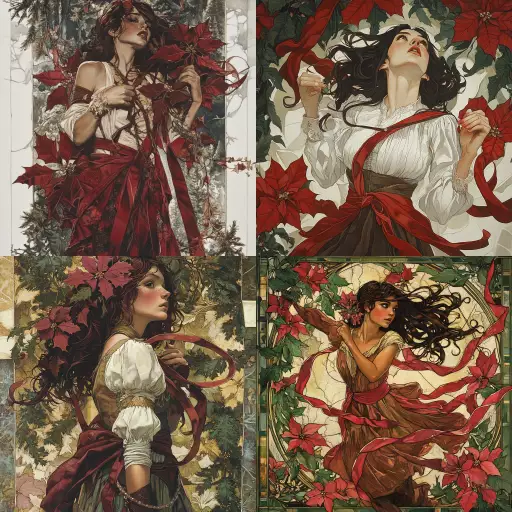Explore the Best AI Image Gallery

Beyond the Canvas: How AI-Generated Visual Content is Transforming the Creative Industry
The realm of creativity is experiencing a seismic shift with the emergence of artificial intelligence (AI)-generated visual content. From stunning artwork to realistic images and immersive 3D environments, AI is pushing the boundaries of whats possible, redefining how we create, consume, and interact with visual media. This transformative technology is leaving an indelible mark on the creative industry, sparking both excitement and debate about its implications.
Expanding Creative Horizons
AI-powered tools are democratizing creativity, empowering individuals with limited artistic skills to generate professional-quality visuals. Imagine a world where anyone can design captivating marketing materials, craft personalized illustrations, or develop immersive game environments without needing extensive technical expertise. This accessibility opens doors for new talent and fosters innovation across diverse sectors.
Applications Across Industries
The applications of AI-generated visual content are vast and ever-expanding:
- Marketing and Advertising: Create eye-catching visuals for social media, websites, and print campaigns, tailoring content to specific audiences.
- Gaming and Entertainment: Generate realistic characters, environments, and assets, streamlining development processes and enhancing gameplay experiences.
- Fashion and Design: Conceptualize new clothing lines, visualize fabric patterns, and personalize designs based on individual preferences.
- Architecture and Real Estate: Produce stunning 3D renderings of buildings, allowing clients to visualize spaces before construction.
- Education and Training: Create interactive simulations and visual aids for learning complex concepts in engaging ways.
Navigating the Ethical Landscape
While AI-generated content offers immense potential, it also raises ethical concerns that require careful consideration:
- Copyright and Ownership: Who owns the rights to AI-generated artwork? Establishing clear guidelines for intellectual property is crucial.
- Bias and Representation: AI algorithms can perpetuate existing biases present in training data, leading to unfair or inaccurate representations. Ensuring diversity and fairness in AI development is paramount.
- Job Displacement: The automation of creative tasks raises concerns about potential job losses in the art and design industries. Upskilling and retraining programs will be essential to navigate this transition.
Shaping the Future of Creativity
The future of AI-generated visual content is brimming with possibilities. We can anticipate:
- Increased Personalization: AI will enable hyper-personalized visuals tailored to individual preferences and contexts.
- Enhanced Collaboration: AI tools will facilitate seamless collaboration between humans and machines, fostering creative synergy.
- Emergence of New Art Forms: AI will inspire the creation of entirely new art forms that blur the lines between technology and creativity.
As we navigate this evolving landscape, its crucial to embrace a responsible and ethical approach to AI-generated visual content. By fostering open dialogue, addressing concerns, and harnessing the power of AI responsibly, we can unlock its full potential to revolutionize the creative industry and empower individuals to express themselves in unprecedented ways.



![**Representation: A dog acting as a private tutor to a child. The dog holds a ruler in its paw and stands at the blackboard to explain a dog diagram to the child. Graphic style: Line drawing, cartoon style, influenced by Franco-Belgian comics, thick black lines, simplified design, vector, black and white only, in the style of Keith Haring or the French comic strip "Alinéa". [IMPORTANT]: A single continuous line extending from one side of the image to the other, minimalist, strong outlines, line drawing, without lifting the hand, ultra-simplified, no shading, entirely white image, drawing created in the center of a sheet of paper. --ar 16:5** - Variations (Strong) by <@627984126871470085> (fast)](https://images.ai-img.art/thumbnails/150/f4e034998ccd869d8a061fd12017514fcd92210eb33d4222dc9b54716223f4dd.webp)






](https://images.ai-img.art/thumbnails/150/9d51c5e673b4f2068b7b01abc35425a06f173b76303adf9ad29ca14302c25b18.webp)



](https://images.ai-img.art/thumbnails/150/157712d76865d557120f9baf988de3d0525225295a2789c89bf2c4a5a96a03d1.webp)

![**Representation: A dog acting as a private tutor to a child. The dog holds a ruler in its paw and stands at the blackboard to explain a dog diagram to the child. Graphic style: Line drawing, cartoon style, influenced by Franco-Belgian comics, thick black lines, simplified design, vector, black and white only, in the style of Keith Haring or the French comic strip "Alinéa". [IMPORTANT]: A single continuous line extending from one side of the image to the other, minimalist, strong outlines, line drawing, without lifting the hand, ultra-simplified, no shading, entirely white image, drawing created in the center of a sheet of paper. --ar 16:5** - <@627984126871470085> (fast)](https://images.ai-img.art/thumbnails/150/7a854648a81e51241dcca8d24dd6e3bfcf07ad1df51baf401c9b729f4cf411fa.webp)






![**Representation: A teenager smiling while thinking about a friendly dog, a comic-style thought bubble with a friendly dog inside. Graphic style: Line drawing, cartoon style, influenced by Franco-Belgian comics, thick black lines, simplified design, vector, black and white only, in the style of Keith Haring or the French comic strip "Alinéa". [IMPORTANT]: A single continuous line extending from one side of the image to the other, minimalist, strong outlines, line drawing, without lifting the hand, ultra-simplified, no shading, entirely white image, drawing created in the center of a sheet of paper. --ar 16:5** - <@627984126871470085> (fast)](https://images.ai-img.art/thumbnails/150/6fc850f638e3dee0c4b121acecad2c8419e02bdeac7f871d625f1003c1c3abe1.webp)














](https://images.ai-img.art/thumbnails/150/51c93500396faff4e7fa8b42bc68033067b16b2230e3496e95c482a581ff0fe9.webp)





